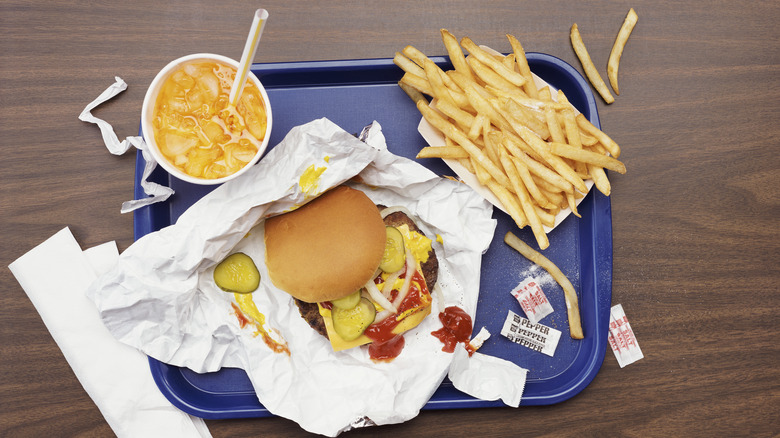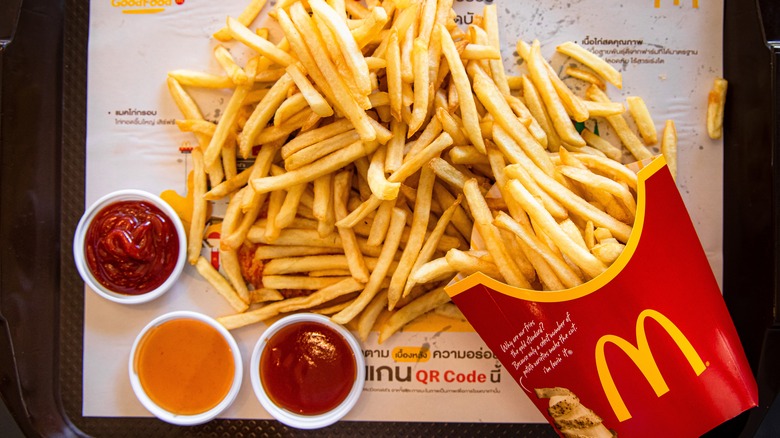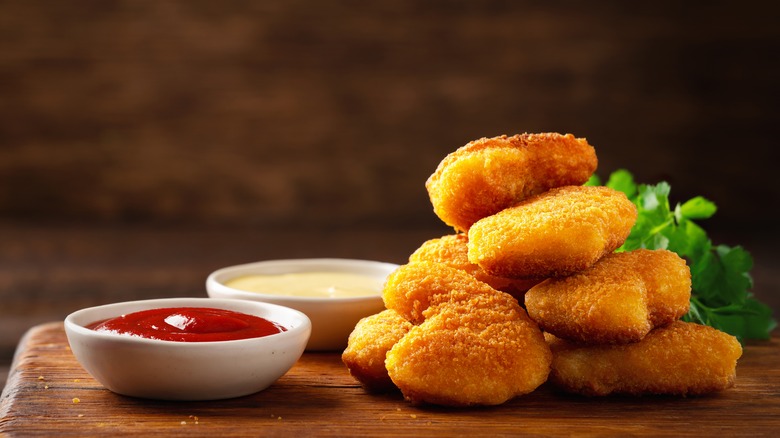14 Questionable Ingredients Hiding In Your Fast Food
Chances are pretty good that you've eaten fast food this week, and you're not alone. It's no surprise that Americans love their fast-food restaurants. As a matter of fact, about 83% of U.S. households consume fast food at least once every week according to recent statistics. Americans just can't seem to get enough of it. The sneaky thing about fast food is that the ingredients aren't listed on the packaging like they are for food products at the grocery store. Instead of glancing at the back of the box, you have to go digging on the company's website to find out exactly what's in your fast food. Out of sight, out of mind ... right?
You can blissfully consume your dinner without reading through the hundreds of ingredients that make up a seemingly simple hamburger and french fries. You might be surprised to find out that fast food contains many questionable ingredients. It's not just loaded with calories and carbs, but also chemicals found inside yoga mats, ingredients made from ground up beetles, and other strange synthetic ingredients that are almost impossible to pronounce.
Azodicarbonamide
Do you remember the infamous "yoga mat chemical" scandal regarding Subway sandwiches back in 2014? It all started when popular food blogger Vani Hari, aka FoodBabe, blasted a petition all over the internet for Subway to remove azodicarbonamide (ADA) from their sandwich bread. ADA is used as a dough conditioner in fast food to help improve the consistency of the bread, but it's also a chemical found in yoga mats and shoe rubber. It's been banned in the U.K., the European Union, and Australia, due to potential health risks, including causing respiratory illness when inhaled and links to cancer in studies involving rats.
Hari's petition was a success and Subway completely removed ADA from their ingredient list. Shortly after, many other fast-food restaurants quietly followed, including McDonald's, Chick-fil-A, Wendy's, White Castle, and Jack in the Box (via Chicago Tribune). But not all of them got rid of it.
Despite concerns over the safety of consuming ADA, the Food and Drug Administration (FDA) still allows its use in food in limited quantities. Burger King claims to have phased out ADA in everything but their french toast sticks, and Arby's still uses ADA in their sourdough breakfast bread, croissants, and french toast sticks.
Dimethylpolysiloxane
Have you ever heard the saying that you should never eat anything you can't pronounce? Well, let's consider adding dimethylpolysiloxane to that list. Dimethylpolysiloxane is commonly used in fast food as an anti-foaming agent that helps reduce oil splatters during the frying process. This helps minimize oil burns on fast food employees, which is a good thing. However, it's also a chemical compound known as silicone and can be often found in skincare products, shampoos, cosmetics, and even kid's Silly Putty (via Treehugger). So should we be eating it?
So far, the World Health Organization has not found any potential negative health issues linked with consuming dimethylpolysiloxane. And a re-evaluation of the substance confirmed that there were no observed negative health outcomes acutely or in the long term. However, it is still unsettling to know you might be consuming an ingredient that's also in your children's toys. Chances are if you are ordering fast food that's been deep-fried, it probably contains dimethylpolysiloxane — like Wendy's natural-cut french fries, according to their website.
Disodium 5'-ribonucleotides
Ever wonder what "natural flavors" means? They're likely comprised of disodium 5'-ribonucleotides, which show up on ingredient lists under the names disodium inosinate and disodium guanylate. These substances are commonly used as flavor enhancers, similar to the notorious monosodium glutamate (MSG). Oftentimes, you'll find both disodium guanylate and MSG used together, while other times disodium inosinate and disodium guanylate are combined to replace MSG entirely. Either way, the combos produce an "umami" or meaty flavor and make food appear to be tastier than it would otherwise.
Disodium guanylate comes from fermented tapioca starch and is actually found naturally occurring in food like fish and mushrooms, which is why it dubiously qualifies as a "natural flavor." You'll find these ingredients in many fast-food menu items, like Wendy's chili con carne and a variety of Arby's options, including their chicken tenders and sauces. It's believed to be safe for consumption, however, more research needs to be done to back up this theory. Healthline recommends that individuals with a history of MSG sensitivity, gout, or kidney stones avoid consuming disodium guanylate.
Sodium phosphate
Sodium phosphate is a general term for a substance that is a combination of salt and phosphate, which is an inorganic chemical. It's commonly found in fast food, deli meat, and other foods as a food thickener, emulsifying agent, leavening agent, or to help cure meat. It's also found on the ingredient list of many household products and medications (via Healthline). You'll find it inside some meats at Subway, as well as the beef, bacon, ham, turkey, and chicken at Arby's, in addition to their cheeses and sauces.
Food-grade sodium phosphate has been deemed safe by the FDA, however, some scientific studies beg to differ. According to one study, inorganic phosphate as a food additive was linked with higher mortality rates, especially for those struggling with kidney and cardiovascular disease. The study also found that high levels of phosphate were associated with faster signs of aging and vascular damage. In addition, Healthline recommends that people with a history of kidney disease, intestinal tears or blockages, colitis, slow moving bowels, or heart failure avoid consuming sodium phosphate.
Sodium acid pyrophosphate
Most people would assume that french fries are made from three simple ingredients: potatoes, oil, and salt. In the fast-food world, this is far from the truth. McDonald's world-famous french fries actually contain 14 ingredients, one of which includes sodium acid pyrophosphate, which is used to "maintain color." As a matter of fact, you'll find this ingredient used as a preservative in a lot of different chains' fast-food french fries. In general, consuming small amounts of sodium acid pyrophosphate is considered safe, according to Livestrong.
However, if you are a regular fast-food customer, listen up. One scientific review states that eating large amounts of food containing sodium acid pyrophosphate in the long-term has been linked to a reduction in immune system function. Plus, consuming sodium acid pyrophosphate adds to the amount of phosphorus in your diet, which can result in brittle bones if you don't get enough calcium.
Natural beef flavor
Another strange and questionable ingredient hiding in McDonald's french fries is natural beef flavor. That's right — McDonald's iconic golden, crispy french fries are not vegetarian. In fact, McDonald's was sued over this fact back in 2001, when Hindu customers discovered they were unknowingly consuming beef — in the form of french fries – which is against their religion (via Treehugger). McDonald's falsely claimed that their fries were fit for vegetarian diets, and for this little fib, they paid $10 million in settlement fees. More than half of that money went to organizations promoting vegetarianism.
Despite all this controversy, McDonald's has only changed their recipe for their restaurants in India, while their french fry formula everywhere else has stayed exactly the same. Sure enough, if you double check the ingredient list of McDonald's french fries on their website, natural beef flavor is included — along with milk, which means even without the natural beef flavor, their french fries still wouldn't be vegan.
Carmine
If you have a fear of bugs in your food, you may want to stop reading now. That's because carmine — also sometimes called cochineal extract and natural red 4, among other names — comes from ground up beetles. To be exact, carmine dye comes from cochineal beetles that are gathered, killed, and dried out, then ground up into a fine powder, which produces a rich red color. It's commonly used as a food dye in drinks, yogurt, processed meats, pastries, juices, and cosmetics (via Treehugger).
In 2012, Starbucks was ridiculed for using it in their strawberry flavored drinks until they announced that they were switching to lycopene, a tomato-based extract, to replace it. Carmine still remains a frequent ingredient in ketchup, which we all know is available at almost every single fast-food restaurant, as per The Howler Monkey. If you really don't want to be eating beetles with your next fast-food meal, be sure to check those ingredient lists. However, sometimes carmine may just be labeled as "natural coloring," so it can be hard to know for sure where it's hiding.
Diacetyl tartaric acid esters of monoglycerides
After many fast-food companies phased out the infamous "yoga mat chemical," they turned to other dough conditioners, like diacetyl tartaric acid esters of monoglycerides, or DATEM for short. DATEM can be found in many fast-food breads, including McDonald's burger buns. It can also be lurking inside coffee creamers, ice cream, salad dressings, and more.
While the FDA has determined DATEM to be safe for consumption, some argue that there have not been enough studies to justify this (via Is It Bad For You). In one scientific study on DATEM consumption in lab animals, it was associated with heart fibrosis and adrenal overgrowth. Medical professionals have also expressed concern that DATEM may be linked to leaky gut syndrome, which is a digestive condition that causes increased intestinal permeability and can lead to long-term health complications. Because of this, some companies like Whole Foods have chosen to ban DATEM from their store shelves altogether.
L-cysteine
L-cysteine is another mysterious dough conditioner. This one is made from all-natural sources, like duck feathers and human hair. According to CNN, L-cysteine is an amino acid that was commonly made from human hair sold to small chemical-processing plants by Chinese women trying to support their families back in the early 2000s. These days, the majority of L-cysteine on the market is commonly made from duck feathers, according to The Vegetarian Resource Group.
Besides the origin story of L-cysteine being a little creepy, it has been deemed safe for consumption by the FDA and there are no negative health outcomes upon consumption to report. You'll find L-cysteine used as a dough conditioner inside McDonald's baked apple pies, as well as menu items from other fast-food chains like Dunkin', Burger King, and Domino's Pizza — although they state that the L-cysteine in Domino's Breadsticks, Cheesy Bread, and Cinna Stix is "vegetable-derived."
Monosodium glutamate
It may come as no surprise to you that fast food still contains the most well-known flavor enhancer of them all: MSG. In fact, fast food is one of the most common places you'll find MSG, according to Healthline. It's a popular ingredient found in many items at both Kentucky Fried Chicken and Chick-fil-A restaurants. MSG is made from the amino acid L-glutamic acid, and is actually naturally occurring in tomatoes, cheeses, and a handful of other foods. It's typically used as a food additive because it makes food taste more delicious by stimulating your taste buds and adding a savory "umami" flavor.
Even though the FDA allows MSG to be added to foods, some studies suggest that consuming it has negative health repercussions. One study involving lab animals found that MSG was associated with obesity, liver damage, blood sugar changes, higher risk of heart disease, behavioral changes, nerve damage, and higher levels of inflammation. Consuming MSG has also been linked with causing increased hunger and a higher risk of developing metabolic syndrome.
Polysorbate 80
Polysorbate 80 is an unnatural compound that comes from dehydrated sugar alcohol and fatty acids commonly used as a food emulsifier to help reduce fat separation in processed foods. It's also often found inside household products and cosmetics. When it comes to fast food, polysorbate 80 can be found in many different restaurant sauces, like the tartar sauce that goes on McDonald's Filet-O-Fish sandwich, and the pickles, french toast sticks, and several sauces at Arby's.
Even though the FDA has approved polysorbate 80 to be safe for human consumption, there have been some scientific studies with concerning results. According to one research review, when undigested, polysorbate 80 has been associated with bacterial growth in the intestines that may be a contributing factor to Crohn's disease. More studies need to be done to examine the potential long-term effects consuming polysorbate 80 may have on the body.
Potassium bromate
Bleached flour is a common ingredient in many fast-food bread products, typically used to reach uniformity with the classic white burger bun. The process of bleaching flour relies on certain chemicals during production, like chlorine or potassium bromate, which then remain in the bread as an additive. Potassium bromate is also commonly added to strengthen the dough, which makes it appear bigger and spongy (via Environmental Working Group).
This chemical has been associated with kidney damage and cancer in several scientific studies involving lab animals and has actually been banned in the European Union, Canada, Brazil, Argentina, and Nigeria (via Healthline). It's also listed as a possible carcinogen by the state of California and the International Agency for Research on Cancer (via Levels). However it still remains legal and widely used across America, and the last time the FDA revisited their approval for this chemical additive was back in 1973.
Tertiary butylhydroquinone
Tertiary butylhydroquinone (TBHQ) is a food additive made from petroleum that is commonly used in processed food as a preservative. Not only will you find it in fast food, but also in things like paints, varnishes, and skin care products (via Healthline). McDonald's uses it in 18 different menu items, including the Fruit and Walnut Salad, Griddle Cakes, and Chicken McNuggets (via Treehugger).
The FDA put a limit on how much TBHQ is considered to be safe — the legal maximum is 0.02% of the food's oil and fat content. However, eating large doses of TBHQ has been known to have negative health consequences. For example, eating one gram — which is pretty hard to do in a single meal, by the way — can cause nausea, vomiting, delirium, and feeling out of breath. In addition, it is important to note that scientific studies on lab animals showed consumption of TBHQ to cause liver growth, tumors, neurotoxic effects, convulsions, and paralysis.
Phthalates
Phthalates are an unintended and potentially harmful ingredient found in many fast-food meals. According to a recently published peer-reviewed analysis that examined 64 food samples of various fast-food items from McDonald's, Burger King, Chipotle, Taco Bell, and more, a majority of them contained phthalates. More than 80% of the fast-food samples tested contained a phthalate called DnBP, while 70% housed another phthalate named DEHP — both of which are associated with causing reproductive health issues, as well as learning and attention challenges in children (via USA Today).
Phthalates are commonly added as a softening agent to plastics, and it's believed that in this case, they were transferred into food from gloves, packaging, and other plastics involved in the fast-food industry. While the levels of phthalates found in the fast-food samples do not exceed the Environmental Protection Agency's health protective limits, it's still a cause for concern that it's been found in the foods that we often eat every week, according to researcher Lariah Edwards, co-author of the study.














